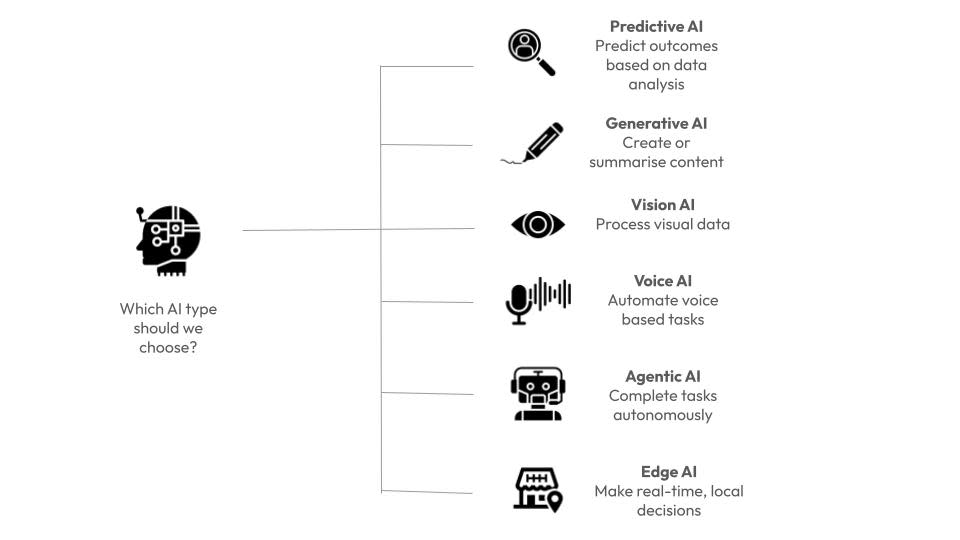TLDR: AI has now become an integral part of enterprise strategy with vast and varied potential applications. However, rapid AI advancement over the last few years has made it increasingly challenging for leaders to stay informed and implement solutions effectively. This article breaks down six key types of AI in 2025, highlighting which industries benefit the most from each.
There are several types of artificial intelligence (AI) available, and adopting the latest AI model just because it's trending isn’t the smartest move. It is like taking a sledgehammer to tasks that may need just a screwdriver.
Smart AI adoption begins with experimenting and operationalising AI types that best align with your business strategy, then expanding gradually to other types as success is achieved at scale. High-impact, cost-effective AI use cases can help you build AI maturity while driving measurable returns.
Understanding Primary AI Categories
Technically speaking, there are two broad AI categories.
Predictive AI
Predictive AI systems can identify statistical patterns in data and predict future outcomes. For example, financial institutions utilise it to flag transactions as potentially fraudulent or genuine. Similarly, energy companies can use predictive AI to forecast electricity demand in a given period.
Predictive AI models must be trained on past, known data to predict future outcomes. For instance, they must be trained on past datasets of known fraudulent transactions. During training, the AI model automatically identifies correlations between various factors, such as transaction value, time, and other considerations, that increase the likelihood of a future transaction being fraudulent.
Predictive AI is best suited for use cases that require guessing the future, but in a controlled manner. For example,
Resource planning by estimating future demand
Price planning based on market trends or competitor activity
Customer product recommendations based on past customer activity
Risk assessments based on set criteria
Schedule optimisation, like planning maintenance, transport routes, or worker schedules, by anticipating workload demand and worker behaviour.
Predictive AI solutions have a narrow focus and must be guided by human-determined data sets and criteria. If trained correctly, they are fast, efficient, and guess with over 90-95% accuracy.
Generative AI
Generative AI models possess a human-like understanding of sequential data, particularly in the context of human language. They have been trained on the data present in millions of books, images, audio, and video files, and can use that information to create their own unique output.
At its core, generative AI is also making predictions. For example, it is predicting the next word in a sentence or the next pixel in the image it is generating. However, it is able to do so in a way that keeps the larger context in mind. It creates meaningful output due to the exponentially more complex model architecture and the exponentially greater training data and computing resources it has access to.
Organisations can use generative AI for advanced problem solving, like:
Intelligent customer service chatbots
Writing/designing assistants
Intelligent enterprise search with results summarisation
Document archive analysis and summarisation
Automated report generation
Early stage triaging
Advanced automated translation
And much, much more. Its ability to meaningfully comprehend content and subject matter means the possibilities are limitless.

Derived AI Types
In practice, we are seeing the emergence of more AI types due to differences in how predictive and generative AI models are trained and deployed. Some systems may also combine generative and predictive capabilities, with multiple models working together under the hood. Consider the following.
Vision AI
Allow machines to interpret and understand visual information from images or videos.
Vision AI systems are trained on vast volumes of image data. They are helpful for use cases like:
Face recognition (e.g. in ID verification)
Object/entity recognition and naming, like automatically labelling anatomy parts in medical images
Image captioning
Generating images and creatives from natural language prompts
Voice AI
Enable computers to understand and respond to spoken commands or questions.
Voice AI systems convert text to human-like speech. AI assistants like Alexa and Siri were early applications of voice AI. Modern versions can ask questions and respond to the user, engaging in natural phone conversations with a very human-like voice. They can simulate emotions, natural pauses, dialects and speed variations to increase engagement.
Use cases include:
Intelligent, preliminary voice response for triaging incoming phone inquiries
Routine sales conversations like changing/making appointments, collecting preliminary customer data, etc.
Pre-screening or data verification over the phone
Agentic AI
Goal-oriented, autonomous systems.
AI agents are generative AI chatbots on steroids. Beyond providing intelligent responses, they can also perform digital actions, such as downloading a file, retrieving data from another system, or sharing data with other agents. They can be trained to make decisions independently and work towards a predetermined goal. A multi-agentic AI system can automate complex business processes, requiring little to no human intervention.
Use cases are industry-specific but can be broadly stated as any advanced process automation, such as onboarding, incident response, and data reporting.
Edge AI
Process AI algorithms directly on local devices rather than in centralised cloud servers.
Most AI systems require significant compute and memory resources to process data and act upon it. Hence, they run in the cloud or a centralised data centre and require applications to move data to and from the system. For example, an AI-powered chatbot application must send the user's question back to the AI model in the cloud and wait until it receives the response over the network.
However, in some situations, a real-time response with AI running physically closer to data sources may be necessary. For example, AI systems that manage grid maintenance tasks should be able to act quickly to shut down or add grid capacity as needed, based on sensor input.
That’s where edge AI comes in. It operates in close proximity to sensor networks and may sometimes run within a smart device, thereby increasing its capabilities.
Use cases include:
Any physical system or network monitoring and management
Any physical resource monitoring and management, like machinery, wind farms, and vehicle fleets
Geodata collection and processing for energy, farming, climate research, etc.
Industry-wise recommendations
AI type | Use case | Business outcome | Industries where more prevalent |
Predictive AI | Forecasting Recommendations Risk assessment Data classification | Supports proactive decision-making. Enhances customer experience. | Energy, Logistics, Finance, Manufacturing |
Generative AI | Assistants/chatbots Document processing Content generation Sentiment analysis | Automates customer service, sales, and marketing workflows to reduce operational costs. | Customer Service, Marketing, Media |
Vision AI | Image generation/processing Image recognition Image captioning Image labelling Image censoring | Gives back hours spent in manual image processing, cutting down operational costs in any image-heavy workflows. | Healthcare, Media, Autonomous Vehicles, Mining, Scientific Research, Security, etc |
Voice AI | Automating phone conversations, screening, and data collection. Voice assistance Subtitles and audio processing | Introduces efficiencies in administrative tasks that involve collecting/processing information over the phone. Enhances customer experience, intelligently guiding customers to the right solution over the phone. | Sales, Media, Human Resource Management, Customer Service |
Agentic AI | Business process automation Data processing and analytics | Has the potential to generate new revenue sources, reimagine customer/employee experiences, and introduce new ways of working in the organisation | Finance, Logistics, Business Analytics |
Edge AI | Physical system monitoring and management Network monitoring and management Geodata collection and processing | Introduce efficiencies and save costs in any physical operations that involve machinery maintenance. Expand geoscientific operations through enhanced data collection and processing. | Energy, Agriculture, Manufacturing, Logistics |
The table above is not prescriptive but rather aims to provide general guidance. Every type of AI has use cases across industries, depending on the specific context. We recommend identifying high-value business use cases where AI impact is maximum and then working backwards to find the AI type that best aligns with organisational needs.
Contact V2 to learn more about how we can help you select the best AI types for your enterprise.




